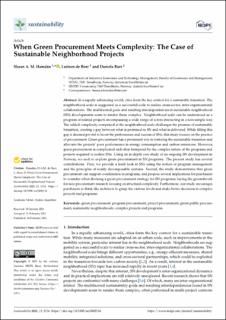| dc.contributor.author | Hamdan, Hasan | |
| dc.contributor.author | De Boer, Luitzen | |
| dc.contributor.author | Baer, Daniela | |
| dc.date.accessioned | 2021-03-08T09:58:43Z | |
| dc.date.available | 2021-03-08T09:58:43Z | |
| dc.date.created | 2021-02-16T16:50:26Z | |
| dc.date.issued | 2021 | |
| dc.identifier.citation | Sustainability. 2021, 13 (4), . | en_US |
| dc.identifier.issn | 2071-1050 | |
| dc.identifier.uri | https://hdl.handle.net/11250/2732094 | |
| dc.description.abstract | In a rapidly urbanizing world, cities form the key context for a sustainable transition. The neighborhood scale is suggested as a successful scale to realize cross-sector, inter-organizational collaborations. The multifaceted goals and resulting interdependencies in sustainable neighborhood (SN) developments seem to render them complex. Neighborhood scale can be understood as a program of related projects encompassing a wide range of actors interacting in a non-simple way. The added complexity comprised at the neighborhood scale challenges the promise of sustainable transition, creating a gap between what is promised as SN and what is delivered. While filling this gap is deemed pivotal to boost the performance and success of SNs, this study focuses on the practice of procurement. Green procurement has a prominent role in fostering the sustainable transition and alleviate the projects’ poor performance in energy consumption and carbon emissions. However, green procurement is complicated and often hampered by the complex nature of the programs and projects required to realize SNs. Using an in-depth case study of an ongoing SN development in Norway, we seek to explore green procurement in SN programs. The present study has several contributions. First, we provide a fresh look at SNs using the notion of program management and the principles of nearly decomposable systems. Second, the study demonstrates that green procurement can support coordination in programs, and propose several implications for purchasers to consider when devising a green procurement strategy for SN programs, laying the groundwork for new procurement research focusing on structural complexity. Furthermore, our study encourages purchasers to think like architects to grasp the various levels and make better decisions in complex projects and programs. | en_US |
| dc.language.iso | eng | en_US |
| dc.publisher | MDPI | en_US |
| dc.rights | Navngivelse 4.0 Internasjonal | * |
| dc.rights.uri | http://creativecommons.org/licenses/by/4.0/deed.no | * |
| dc.title | When Green Procurement Meets Complexity: The Case of Sustainable Neighborhood Projects | en_US |
| dc.type | Peer reviewed | en_US |
| dc.type | Journal article | en_US |
| dc.description.version | publishedVersion | en_US |
| dc.source.pagenumber | 21 | en_US |
| dc.source.volume | 13 | en_US |
| dc.source.journal | Sustainability | en_US |
| dc.source.issue | 4 | en_US |
| dc.identifier.doi | https://doi.org/10.3390/su13042116 | |
| dc.identifier.cristin | 1890553 | |
| dc.relation.project | Norges forskningsråd: 257660 | en_US |
| dc.description.localcode | This is an open access article distributed under the Creative Commons Attribution License which permits unrestricted use, distribution, and reproduction in any medium, provided the original work is properly cited. | en_US |
| cristin.ispublished | true | |
| cristin.fulltext | original | |
| cristin.qualitycode | 1 | |

